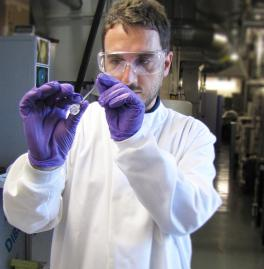Mar 18 2020
Scientists from the University of Southampton’s Zepler Institute for Photonics and Nanoelectronics have illustrated a new advancement in the performance of hollow-core fibers, underscoring the potential of the technology to soon replace the existing optical fibers.
 This is professor Francesco Poletti, Head of Hollow Core Fiber group. Image Credit: University of Southampton.
This is professor Francesco Poletti, Head of Hollow Core Fiber group. Image Credit: University of Southampton.
Hollow-core fibers substitute traditional glass cores with a vacuum or gas to allow special properties such as decreased sensitivity to environmental changes and faster light speed.
It is believed that the innovative technology, which is being developed in the well-known Optoelectronics Research Centre of Zepler Institute, would be able to reach higher data transmission capacity and lower loss when compared to that of all-solid glass fibers, with present research expediting models toward this ultimate performance.
Scientists and collaborators from the University of Southampton will present the new results in San Diego in two prominent post-deadline papers at OFC 2020—the largest optical fiber communication conference in the world.
Light passing through the new hollow-core fibers is attenuated by 50% less than that of the earlier record, reported just six months back. The highest length of transmission at which data can be transmitted in such advanced hollow-core fibers has also increased by two-fold.
The Optoelectronics Research Centre proposed a novel design which, in a span of 18 months, made it possible to reduce the attenuation in data-relaying hollow-core fibers by over a factor of 10—that is, from 3.5dB/km to just 0.28 dB/km—within a factor of two of the attenuation of traditional all-glass fiber technology.
Simultaneously, the highest distance of transmission, at which large-bandwidth data streams can be relayed via an air-core, has been enhanced by more than tenfold, that is, from 75 to 750 km.
Transmitting light in an air core rather than a glass core presents many advantages which could revolutionise optical communications as we know them. These latest results further reduce the performance gap between hollow core fibre and mainstream optical fibre technology, and the whole team is really excited by the prospect of the additional significant improvements that seem possible, according to modelling.
Francesco Poletti, Professor, Optoelectronics Research Centre, University of Southampton
Poletti continued, “Latency, which is the round-trip time for communications, is becoming as important as bandwidth for the new digital economy. Network latency creates a delay between sensing and its response, causing sickness in AR/VR users, loss of fidelity in remote surgery and accidents in autonomous systems.”
These fibers deliver a vital 30% reduction in round-trip data transmission times and could enable the next generation of connected real-time digital applications, from smart manufacturing and advanced healthcare to the entertainment.
Francesco Poletti, Professor, Optoelectronics Research Centre, University of Southampton
Poletti is also the Head of the hollow core fiber group at the Optoelectronics Research Centre.
The substantial enhancements in attenuation, as well as transmission distance illustrated in these two studies, offer the prospect to focus on longer reach distances that come close to the 1,000-km span of regular long-haul, long-distance terrestrial data transmission links.
Scientists at the University of Southampton are now pushing the limitations of hollow-core performance in many important research programs, such as the LightPipe project supported by the European Research Council, and the Airguide Photonics project sponsored by the Engineering and Physical Sciences Research Council (EPSRC).
The researchers are working closely with one of the top teams in cutting-edge optical communications at the Politecnico di Torino, headed by Professor Pierluigi Poggiolini and Lumenisity, a spinout of Optoelectronics Research Centre.